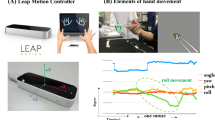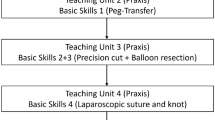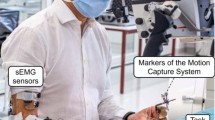Abstract
Purpose
Attaining sufficient microsurgical skills is paramount for neurosurgical trainees. Kinematic analysis of surgical instruments using video offers the potential for an objective assessment of microsurgical proficiency, thereby enhancing surgical training and patient safety. The purposes of this study were to develop a deep-learning-based automated instrument tip-detection algorithm, and to validate its performance in microvascular anastomosis training.
Methods
An automated instrument tip-tracking algorithm was developed and trained using YOLOv2, based on clinical microsurgical videos and microvascular anastomosis practice videos. With this model, we measured motion economy (procedural time and path distance) and motion smoothness (normalized jerk index) during the task of suturing artificial blood vessels for end-to-side anastomosis. These parameters were validated using traditional criteria-based rating scales and were compared across surgeons with varying microsurgical experience (novice, intermediate, and expert). The suturing task was deconstructed into four distinct phases, and parameters within each phase were compared between novice and expert surgeons.
Results
The high accuracy of the developed model was indicated by a mean Dice similarity coefficient of 0.87. Deep learning-based parameters (procedural time, path distance, and normalized jerk index) exhibited correlations with traditional criteria-based rating scales and surgeons’ years of experience. Experts completed the suturing task faster than novices. The total path distance for the right (dominant) side instrument movement was shorter for experts compared to novices. However, for the left (non-dominant) side, differences between the two groups were observed only in specific phases. The normalized jerk index for both the right and left sides was significantly lower in the expert than in the novice groups, and receiver operating characteristic analysis showed strong discriminative ability.
Conclusion
The deep learning-based kinematic analytic approach for surgical instruments proves beneficial in assessing performance in microvascular anastomosis. Moreover, this methodology can be adapted for use in clinical settings.







Similar content being viewed by others
Data availability
The data that support the findings of this study are available from the corresponding author upon reasonable request.
References
Aoun SG, El Ahmadieh TY, El Tecle NE, Daou MR, Adel JG, Park CS, Batjer HH, Bendok BR (2015) A pilot study to assess the construct and face validity of the Northwestern Objective Microanastomosis Assessment Tool. J Neurosurg 123(1):103–109
Belykh E, Abramov I, Bardonova L et al (2022) Seven bypasses simulation set: description and validity assessment of novel models for microneurosurgical training. J Neurosurg 138(3):732–739
Castillo-Segura P, Fernández-Panadero C, Alario-Hoyos C, Muñoz-Merino PJ, Delgado Kloos C (2021) Objective and automated assessment of surgical technical skills with IoT systems: a systematic literature review. Artif Intell Med 112:102007
Chmarra MK, Kolkman W, Jansen FW, Grimbergen CA, Dankelman J (2007) The influence of experience and camera holding on laparoscopic instrument movements measured with the TrEndo tracking system. Surg Endosc Other Interv Tech Surg Endosc 2069–2075
Datta V, Mackay S, Mandalia M, Darzi A (2001) The use of electromagnetic motion tracking analysis to objectively measure open surgical skill in the laboratory-based model. J Am Coll Surg 193(5):479–485
Davids J, Makariou SG, Ashrafian H, Darzi A, Marcus HJ, Giannarou S (2021) Automated vision-based microsurgical skill analysis in neurosurgery using deep learning: development and preclinical validation. World Neurosurg 149:e669–e686
Fujimura M, Tominaga T, Kuroda S, Takahashi JC, Endo H, Ogasawara K, Miyamoto S (2022) 2021 Japanese guidelines for the management of moyamoya disease: guidelines from the Research Committee on Moyamoya Disease and Japan Stroke Society. Neurol Med Chir (Tokyo) 62(4):165–170
Ghasemloonia A, Maddahi Y, Zareinia K, Lama S, Dort JC, Sutherland GR (2017) Surgical skill assessment using motion quality and smoothness. J Surg Educ 74(2):295–305
Harada K, Morita A, Minakawa Y, Baek YM, Sora S, Sugita N, Kimura T, Tanikawa R, Ishikawa T, Mitsuishi M (2015) Assessing microneurosurgical skill with medico-engineering technology. World Neurosurg 84(4):964–971
Housley SB, Vakharia K, Gong AD, Waqas M, Rho K, Levy EI, Davies JM, Siddiqui AH (2022) Extracranial-to-intracranial bypass for distal internal carotid artery and/or proximal middle cerebral artery steno-occlusive disease: a case series of clinical outcomes at a single, high-volume cerebrovascular center. Oper Neurosurg 23(3):177–181
Khalid S, Goldenberg M, Grantcharov T, Taati B, Rudzicz F (2020) Evaluation of deep learning models for identifying surgical actions and measuring performance. JAMA Netw open 3(3):e201664
Lam K, Chen J, Wang Z, Iqbal FM, Darzi A, Lo B, Purkayastha S, Kinross JM (2022) Machine learning for technical skill assessment in surgery: a systematic review. npj Digit Med 5(1):24
Lawton MT, Lang MJ (2019) The future of open vascular neurosurgery: perspectives on cavernous malformations, AVMs, and bypasses for complex aneurysms. J Neurosurg 130(5):1409–1425
Mackay S, Datta V, Mandalia M, Bassett P, Darzi A (2002) Electromagnetic motion analysis in the assessment of surgical skill: relationship between time and movement. ANZ J Surg 72(9):632–634
Martin JA, Regehr G, Reznick R, Macrae H, Murnaghan J, Hutchison C, Brown M (1997) Objective structured assessment of technical skill (OSATS) for surgical residents. Br J Surg 84(2):273–278
McBeth PB, Louw DF, Yang F, Sutherland GR (2005) Quantitative measures of performance in microvascular anastomoses. Comput Aided Surg 10(3):173–180
McGoldrick RB, Davis CR, Paro J, Hui K, Nguyen D, Lee GK (2015) Motion analysis for microsurgical training: objective measures of dexterity, economy of movement, and ability. Plast Reconstr Surg 136(2):231e–240e
Mikami T, Suzuki H, Ukai R, Komatsu K, Kimura Y, Akiyama Y, Wanibuchi M, Mikuni N (2018) Surgical anatomy of rats for the training of microvascular anastomosis. World Neurosurg 120:e1310–e1318
Miyamoto S, Yoshimoto T, Hashimoto N et al (2014) Effects of extracranial-intracranial bypass for patients with hemorrhagic moyamoya disease: results of the Japan adult moyamoya trial. Stroke 45(5):1415–1421
Niveditha M, Sharma R, Suri A (2022) Microsurgical suturing assessment scores: a systematic review. Neurosurg Rev 45(1):119–124
Pines AR, Alghoul MS, Hamade YJ et al (2017) Assessment of the interrater reliability of the congress of neurological surgeons microanastomosis assessment scale. Oper Neurosurg 13(1):108–112
Rashad S, Fujimura M, Niizuma K, Endo H, Tominaga T (2016) Long-term follow-up of pediatric moyamoya disease treated by combined direct–indirect revascularization surgery: single institute experience with surgical and perioperative management. Neurosurg Rev 39(4):615–623
Reynolds MR, Grubb RL, Clarke WR, Powers WJ, Zipfel GJ, Adams HP, Derdeyn CP (2013) Investigating the mechanisms of perioperative ischemic stroke in the Carotid Occlusion Surgery Study. J Neurosurg 119(4):988–995
Satterwhite T, Son J, Carey J, Echo A, Spurling T, Paro J, Gurtner G, Chang J, Lee GK (2014) The stanford microsurgery and resident training (SMaRT) scale: validation of an on-line global rating scale for technical assessment. Ann Plast Surg 72(SUPPL. 1):S84–S88
Sekhar LN, Kalavakonda C (2002) Cerebral revascularization for aneurysms and tumors. Neurosurgery 50(2):321–331
Sugimori H, Sugiyama T, Nakayama N, Yamashita A, Ogasawara K (2020) Development of a deep learning-based algorithm to detect the distal end of a surgical instrument. Appl Sci 10(12):4245
Sugiyama T (2017) Mastering intracranial microvascular anastomoses—basic techniques and surgical pearls. Medicus Shuppan, Publishers Co., Ltd
Sugiyama T, Clapp T, Nelson J et al (2021) Immersive 3-dimensional virtual reality modeling for case-specific presurgical discussions in cerebrovascular neurosurgery. Oper Neurosurg 20(3):289–299
Sugiyama T, Gan LS, Zareinia K, Lama S, Sutherland GR (2017) Tool-tissue interaction forces in brain arteriovenous malformation surgery. World Neurosurg 102:221–228
Sugiyama T, Ito M, Sugimori H et al (2023) Tissue acceleration as a novel metric for surgical performance during carotid endarterectomy. Oper Neurosurg 25(4):343–352
Sugiyama T, Kazumata K, Asaoka K, Osanai T, Shimbo D, Uchida K, Yokoyama Y, Nakayama N, Itamoto K, Houkin K (2015) Reappraisal of microsurgical revascularization for anterior circulation ischemia in patients with progressive stroke. World Neurosurg 84(6):1579–1588
Sugiyama T, Lama S, Gan LS, Maddahi Y, Zareinia K, Sutherland GR (2018) Forces of tool-tissue interaction to assess surgical skill level. JAMA Surg 153(3):234–242
Sugiyama T, Nakamura T, Ito Y, Tokairin K, Kazumata K, Nakayama N, Houkin K (2019) A pilot study on measuring tissue motion during carotid surgery using video-based analyses for the objective assessment of surgical performance. World J Surg 43(9):2309–2319
Takagi Y, Kikuta KI, Nozaki K, Hashimoto N (2007) Histological features of middle cerebral arteries from patients treated for moyamoya disease. Neurol Med Chir (Tokyo) 47(1):1–4
Wolfswinkel EM, Landau MJ, Ravina K, Kokot NC, Russin JJ, Carey JN (2018) EC-IC bypass for cerebral revascularization following skull base tumor resection: current practices and innovations. J Surg Oncol 118(5):815–825
Zareinia K, Maddahi Y, Gan LS, Ghasemloonia A, Lama S, Sugiyama T, Yang FW, Sutherland GR (2016) A force-sensing bipolar forceps to quantify tool-tissue interaction forces in microsurgery. IEEE/ASME Trans Mechatron 21(5):2365–2377
Acknowledgements
We would like to thank Editage (www.editage.com) for English language editing.
We thank Masaki Mizuhara (Integra Japan Co., Ltd.), Kazuhiro Goto (Zeiss Japan Co., Ltd.), and Shusaku Tsutsui (Johnson & Johnson Inc.) for their support in organizing microvascular hands-on training courses.
Funding
This work was supported by the Japanese Society for the Promotion of Science KAKENHI Grant Number 21K09091.
Author information
Authors and Affiliations
Contributions
TS, HS, and MT contributed to the study conception and design. Data collection was performed by TS, YI, MG, HU, and MI. Data analysis was performed by HS and MT. KO and MF contributed to supervision of the study. The first draft of the manuscript was written by HS and TS. TS critically revised the manuscript, and all authors approved the final version of the manuscript.
Corresponding author
Ethics declarations
Ethical approval
All procedures performed in studies involving human participants were in accordance with the ethical standards of the institutional and/or national research committee and with the 1964 Helsinki Declaration and its later amendments or comparable ethical standards. This study was approved by the institutional review board of Hokkaido University Hospital, Sapporo, Japan (No. 018–0291).
Consent to participate
Informed consent was obtained from all individual participants included in this study.
Conflict of interest
The authors declare no competing interests.
Additional information
Publisher's Note
Springer Nature remains neutral with regard to jurisdictional claims in published maps and institutional affiliations.
Supplementary Information
Below is the link to the electronic supplementary material.
Rights and permissions
Springer Nature or its licensor (e.g. a society or other partner) holds exclusive rights to this article under a publishing agreement with the author(s) or other rightsholder(s); author self-archiving of the accepted manuscript version of this article is solely governed by the terms of such publishing agreement and applicable law.
About this article
Cite this article
Sugiyama, T., Sugimori, H., Tang, M. et al. Deep learning-based video-analysis of instrument motion in microvascular anastomosis training. Acta Neurochir 166, 6 (2024). https://doi.org/10.1007/s00701-024-05896-4
Received:
Accepted:
Published:
DOI: https://doi.org/10.1007/s00701-024-05896-4




